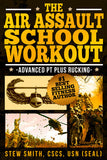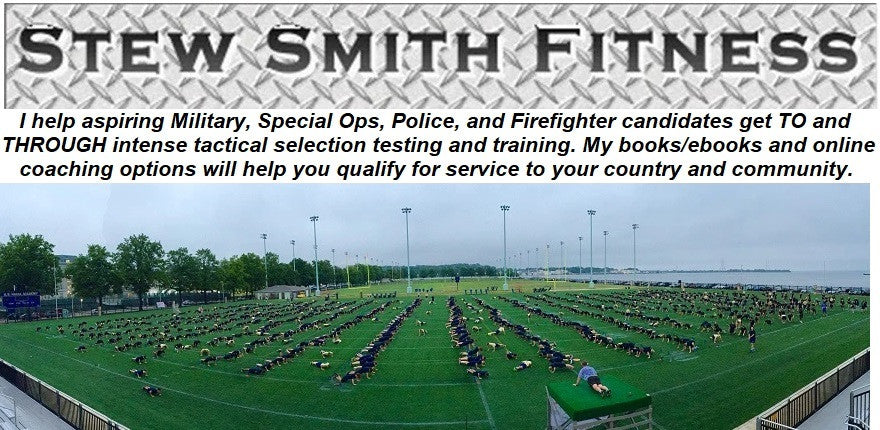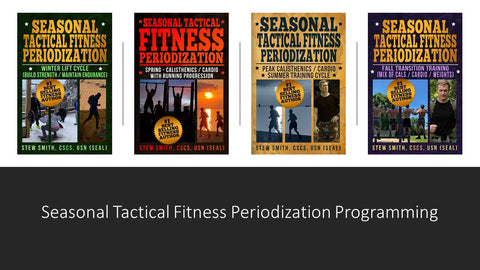Developing and Grading Fitness Tests
(For Personal or Professional Assessments)

There is much that goes into creating a fitness test. The creators must consider effectiveness, logistics, usefulness, and validity of any exercise placed in a test. I personally like creating fitness assessments and challenges for my groups and myself that test ALL of the elements of fitness and many of the skills needed for a tactical athlete. See below for the question that prompted this discussion and my answer on fitness testing relevance:
Often I receive emails from military and law enforcement personnel concerning how fair a fitness test is and does it accurately measure someone’s fitness level. For instance, here is an email from on police officer who is seeking candidates for his department’s SWAT Team:
I am about to open up tryouts for a few SWAT Team positions and am trying to develop a fitness test that will help the Team select the best candidates to attend our training program. Any suggestions?
There are two things most military and law enforcement groups should try to measure: Basic Fitness / Health and Physical Potential to Succeed in Advanced Training.

Basic Fitness / Health - The reasoning for the basic fitness test is to ensure a certain level of health and well-being which will have an impact on job performance, decreased sick days, and a better mental attitude in a stressful environment. Training for a cardio test of a 2 mile run or a 12 minute swim test would require people to exercise regularly and help with maintaining a leaner body mass. The strength, muscle endurance, and flexibility will help with injury prevention from doing odd movements that may require some sort of load bearing activity. Remember, the goal is to create healthy people in the public service work force.
Standard fitness tests used today usually are good indicators of one’s health, not necessarily an indication of satisfactory job performance. Basically, the run, pushups, sit-ups test most groups perform will give a selection board only a minimal amount of information, but it is still a valid test to assess with current fitness standards scores. Many groups have used scoring of these basic tests to assess whether or not someone has a ability to succeed without injury in a particular police/fire academy, SWAT selection, or basic military / spec ops training as well. Often a higher score on even the most basic of fitness tests can statistically show a greater chance of graduation for any candidate.

However, Physical Potential to Succeed in Advanced Training testing can offer more insight if graded the following method: (my opinion)
First, these tests should be more directed toward strength, endurance, speed, and agility in a job related method if possible. For instance, if you are a SWAT Team with many water sources in your jurisdiction or a military Special Ops selection team, here is an example test and grading method:
Swim – 300 – 500m swim with fins or without fins
Treading water with and without hands 1-2 minutes
(See related article to help with both swim and tread)
Agility test – there are many examples to choose from but the Illinois Agility Test, stair climb with gear, a shuttle run, or 300m run with hurdles / obstacles would suffice. An obstacle course is also another way to test speed and agility.
Max Pushups in 2 minutes or body weight bench press – max reps
Max Situps or plank pose in 2 minutes
Max Pullups and / or rope or caving ladder climbs
1 mile run with gear
1.5 to 3 mile run without gear
Then there are more job related events you can also test such as:
Equipment carry (2 x 50m kettlebell farmerwalk)
Fireman carry 100m or buddy tow 25m in water.

How to Grade Such a Test
This type of test will help assess some level of tactical athleticism and can be altered with a variety of different tests, but the interesting way to grade this type of test will help with the ranking and selection process of your group.
See example below:
One way to create a fair scoring system is to create a test that has some form of cardio / upper body / speed / agility / lower body set up so you would score it like this:
Cardio + Speed & agility run - add both up in seconds
(sample test below)
|
Events |
Time |
Points |
|
1.5 mile run |
10 minutes = 600 seconds |
600 points |
| 300m swim | 5 minutes = 300 seconds | 300 points |
|
300m sprint with hurdles |
60 (5x each seconds) |
300 points |
| Total Cardio Events | 1200 points |
1.5 mile run in 10 minutes = 600 seconds / points +
300m swim in 5 minutes = 300 points
300m sprint with obstacles to weave / jump done in 60 seconds = 60 (x5) = 300 points) - The sprint is counted 5x as much for each second.
The cardio base score is 1200 points...
Strength Events (add reps as points)
|
Strength Events |
Example Scores |
Points |
|
# 1 – Pushups with armor (20 lbs) |
50 reps |
50 points |
|
# 2 – Long jump |
80 inches |
80 points |
|
#3 - Pullups with armor (20 lbs) |
10 reps (each rep = 5 points) |
50 points |
|
#4 - Bodyweight Bench Press |
10 reps |
100 points |
|
#5 - Hex Bar Dead Lift (1.5 x bodyweight) |
9 reps. 10-100 points (each rep equals 10 points) |
90 points |
|
Total Strength Scores |
|
370 points |
The upperbody muscle stamina exercise # 1 (push) pushups, ammo can lift, bench press, med ball throw etc ( pick one) - max reps in 2:00 - say you get 50 reps = 50 points
Lowerbody power #1 - sample(long jump, vertical jump, or squat test max reps in 2 minutes etc) - add distance in inches = points - say you get long jump of 80 inches = 80 points...
Upperbody strength/endurance exercise #2 (pull) - max reps of Pullups (x 6) with body armor: 10 reps = 50 points
Upper body Strength #3 - Body weight bench for max reps with a goal is to perform 1x bodyweight for 1-15 reps. 1 Minimum and 15 maximum. Say you get 10 reps - that equals 100 points.
Lower Body Strength #2 - Dead lift (hex or straight bar) goal is to perform 1.5x bodyweight for 1-15 reps. 1 Minimum and 10 maximum. Say you get 9 reps - that equals 90 points.
Now the scoring method for the above example:
Cardio Scores: 600+300+ 300 points for cardio = 1200
Strength Scores: (50 + 80 + 50 + 100 + 90= ) = 370 points (now subtract Strength event scores that are added together)
1200- 370 = 830 is the composite score.
The lowest score is the best score in the competition wins.
*another option that I think is a fair thing to consider is to subtract bodyweight because a 200 lbs person doing this compared to a 150lb person is more impressive especially with the higher repetition calisthenics and cardio events.
Then setting up scoring criteria is easy, but completely subjective by the graders to what you create for your test. The thing this test will do is rank them numerically for the assessment team.
For instance:
less than 800 - Outstanding
801-850 - Above Average
851-900 - Average - passing
901-1000 - Below average - minimum standard
greater than 1001 - failing
This test is just an example to demonstrate an idea for scoring criteria. Obstacle courses, shooting skills, and other job related events could and should be tested and graded on a different scale.
A Potentially Controversial Option But It is Fair IF Grading Work Capability of a Student: Adding in bodyweight and subtracting from total scores insures that testing can be scored fairly when competing for a slot in a Spec Ops unit. Say a 200 lbs person get 10 pullups and a 150 lb person gets 10 pullups – the 200 lbs did more work and deserves more points (in my opinion). Remember, I like to multiply pull-ups and sprint seconds by FIVE (x5) for the fitness test to give it as much weight as 2 minutes of pushups and situps. This gives the pullup test an actual exertion assessment pound for pound.
We used to do this type of scoring trying to figure out who went to SEAL Training from the Naval Academy and found it helpful when selecting only 15 candidates for training out of 50 excellent candidates. Of course, the interview, resume, grades, and other factors were considered, but having a numerical value next to their physical tests gave us a ranking system to use to assess physical potential to make it through the training.
More Ideas for Tactical Fitness Tests Popular Today
The newly designed tactical fitness tests should focus on all of the elements of fitness to include strength, power, speed, agility, as well as muscle stamina and cardio endurance.

See how all the elements of fitness, nutrition, recovery, and mindset fit into the big picture of the Tactical Athlete. The two training plans below were my first to incorporate a Block Periodization model where we focused on our weakness for 3 weeks and deloaded with our strengths for the 4th week of the cycle. Both are 16 weeks one is a lifting program for strength and mass increases with a PST / IFT deload focus. The other is a progressive running / cardio and calisthenics plan with a strength maintenance 4th week of the 4 x 4 week cycles.

There are different names for these new tests for instance:
Combat Fitness Test - Army and Marine Corps
Ranger Physical Assessment Test (RPAT) - Army Ranger
Operator Fitness Test - Air Force Special Warfare
Human Performance Test - Navy SEAL / SWCC / EOD / Diver
Candidate Physical Aptitude Test (CPAT) - Fire Service
|
AFSW Operator Fitness Test (OFT) |
Ranger - RAW Physical Assessment Test (RPAT): |
|
3 mile ruck 1500m Swim with fins (Side, CSS, LATA side stroke) |
3 rep max trap bar deadlift
|
|
|
|
|
Army CFT (see link) |
USMC CFT + PFT (see link) |
|
3 Rep max - Trap bar Dead lift |
Run 880 yards in battle dress uniform. Lift a 30-pound ammo can push press. 300-yard shuttle run of sprints, agility course, high crawl, low crawl, body drag, fireman carry, ammo can carry, push-ups and grenade throw. |
|
|
|
|
Navy Spec War / Spec Ops Human Performance Test |
Fire Fighter CPAT (see link for more details) |
|
800m swim
|
Stair Climb – 60 steps/minute with 25lb vest (stair climber machine) Hose Drag – Drag 200ft hose for 100ft – then pull 50ft of hose hang over hand on one knee position. Equipment Carry – Carry Two Saws 150ft, lift back onto truck shelf. Ladder Raise and Extension -raise and lower a 24ft ladder. Forcible Entry – Swing 10 lbs sledgehammer with enough force to open door / break wall. Search – Crawl / navigate through 64ft of dark tunnel. Rescue -Drag 165lb dummy 70ft (2 x 35ft) Ceiling Breach and Pull – Using Pike Pole Push / Pull ceiling weight of 60 / 80 lbs several times. |
You can see many similarities with the military tactical fitness tests compared to each other. Now, compare / contrast the Above Tests to the Tactical Fitness and Tactical Strength Book Tests created separately. These workout programs are created around the tactical fitness elements to offer a complete program for ALL the elements of tactical fitness.
More information see Seasonal Tactical Fitness Periodization
Tactical Fitness
|
Tactical Strength Test |
|
500m swim plus 25m buddy tow |
500m swim any stroke |
|
3 mile run |
Kb swing / snatch 5 min test (30%BW) |
|
400m sprint |
1-2xBW Squat |
|
Illinois Agility Test |
Pro-agility (5-10-5) |
|
BW Bench Press - Max Rep |
Max 1RM bench |
|
1.5 BW Dead lift - Max Rep |
1.5-2xBW Dead Lift |
|
Pullups (25 lbs vest - max) |
Pullups (25 lbs vest - max) |
|
300yd shuttle run (6 x 50yd) |
300yd shuttle run 12 x 25yd |
|
Plank pose 1-5 minutes |
Strong Man Hang from Bar for time |
|
100m fireman carry of equal body weight |
4 mile ruck (50lbs) |
|
4 mile ruck (50lbs) |
Both programs have equipment carry, crawls, and other lift, calisthenics, cardio options as well |
The Fire Fighter Test - For decades the fire fighters have long had an actual job related physical fitness test used for both recruit candidates as well as competitions in the fire house.
The CPAT is a little more specialized and requires actual fire fighting equipment, but you can still prepare for the movements and conditioning of the CPAT. See related program.
If you want help, that’s what I do…. Check out these resources that have helped spec ops candidates succeed where others have failed for the last 20+ years!
Training is What We Do:
Need Programming for Fitness Tests and Beyond? We are all about getting you TO and THROUGH your future training program. See how that works.
There is More To StewSmithFitness.com than a You May Know
(In fact, there are more than 40 books, 1000+ articles, online coaching - and more)

Who is Stew Smith CSCS? Coach, Trainer, Writer, Podcaster: I'm the former Navy SEAL that tactical candidates go to for books, ebooks and online coaching to prepare themselves to get to and through intense tactical assessment and selection programs and qualify for service in their chosen tactical profession. See More at StewSmithFitness.com
Where to Find More Information About Optimal Performance Training Programs
When you start training again, consider the seasonal tactical fitness model. I call it A WAY to train and obviously not the only way to train. But it offers the opportunity to never neglect your weaknesses, helps with flexibility and mobility, but will also put you at a level of physical abilities where you are happy with your overall ability to do just about anything. We have a system where the seasons dictate our training. When it is nicer outside, we tend to run and do more calisthenics. When it is colder and not so nice, we lift more, run less, and still maintain our outdoor activities with shorter runs and rucks. Check it out: Seasonal Tactical Fitness Periodization System.
These Seasonal Tactical Fitness BLOCK Periodization programs will walk you through 4 x 4 weeks cycles with 16 weeks of each season in two programs. (32 total weeks)

Increase Strength & Crush the PST / PAST
3 Weeks Strength - 1 Week PT / Cardio Focus
(16 weeks)
These programs will walk you through 4 cycles with 12 weeks of each season in two programs.
The Specific Military / Special Ops Physical Fitness Workouts
Navy SEAL Workout Phase 1
Navy SEAL Workout Phase 2 - 3
Navy SEAL Workout Phase 4 Grinder PT
Navy SWCC Workout
Army / Air Force Advanced Fitness / Special Ops
Army PFT Workout (Prep For Rucking, OPAT, ACFT)
Army Special Forces / Ranger Workout
Army Air Assault School Workout
Army Airborne Workout
Air Force Special Warfare IFT / OFT / Selection Prep






Advanced Running Program - Special Ops Supplement Plan
USMC RECON / MarSOC Workout
USMC OCS / TBS Workout
USMC IST and PFT
The Combat Conditioning Workout
Air Force PJ / CCT Workout Battlefield Airman Prep Course
The UBRR Upper Body Round Robin Workout / Spec Ops version
The Coast Guard Rescue Swimmer / Navy SAR Workout
The Service Academy Workout (West Point, Navy, Air Force Academy)
The Navy, Air Force, Marine Corp Boot Camp Workout
The Law Enforcement Physical Fitness Workouts
The FBI Academy Workout | FBI Workout Vol 2
The DEA Workout
The FLETC Workout - Ace the PEB
The PFT Bible: Pushups, Sit-ups, 1.5 Mile Run
The Fire Fighter Workout - Ace the CPAT
Online Coaching Options
Online PT CLUB - Weekly Workouts created personally for you.
New Member's Only Content / Services Program!
If you want access to years worth of workouts, many of the top eBOOKs, favorite workouts of the week, free fitness APP, closed Facebook Group, video / picture library of exercises, and more access to LIVE Q/A sessions check out the Stew Smith Fitness Members Section.
The dashboard below has the links to all the information, archives, videos, and links to workouts, podcasts, live Q and A lessons.
Consider this! - A Membership Program and Gain Access to Exclusive Content
(click for Fitness Club Dashboard - members only)
Questions? Just email - Stew@StewSmith.com
At StewSmith.com - List of Products and Services
- FREE Articles
- Podcasts and Swimming Videos (Youtube, TikTok, Instagram)
- eBooks
- Books and eBooks in PRINT
- Stew Smith Fitness Club membership site
- Online Coaching
Stew Smith Fitness
























